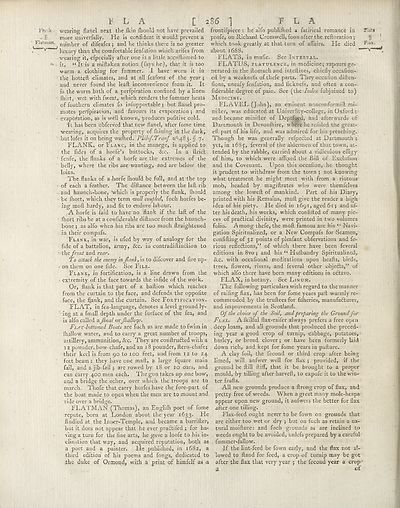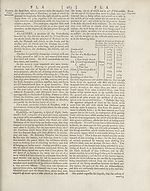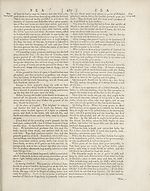Encyclopaedia Britannica > Volume 7, ETM-GOA
(310) Page 286
Download files
Complete book:
Individual page:
Thumbnail gallery: Grid view | List view

FLA
Fkuik wearing fianel next the Hein fliould not have prevailed
J] more univerfalljr. He is confident it would prevent a
Flatman. _ number of difeafes ; and he thinks there is no greater
. v ' luxury than the comfortable fenfation which arifes from
wearing it, efpecially after one is a little accuftomed to
** it. “It is a miftaken notion.(fays he), that it is too
warm a clothing for fummer. I have worn it in
the hotteft climates, and at all feafons of the year ;
and never found the leaft inconvenience from it. It
is the warm bath of a perfpiration confined by a linen
fhirt, wet with fweat, which renders the fummer heats
of fouthern climates fo infupportable ; but flanel pro¬
motes perfpiration, and favours its evaporation ; and
evaporation, as is well known, produces pofitive cold.
It has been obferved that new flanel, after fome time
■wearing, acquires the property of fliining in the dark,
but lofes it on being wafhed. Philof.Tranf- n^Sj. $ 7.
FLANK, or Flanc, in the manege, is applied to
the fides of a horfe’s buttocks, &c.. In a firidt
fenfe, the flanks of a horfe are the extremes of the
belly, where the ribs are wanting, and are below the
loins.
The flanks of a horfe (houtd be full, and at the top
of each a feather. The diftance between the laft rib
, and haunch-bone, Ewhich is properly the flank, Ihould
be ihort, which they term well coupled, fuch horfes be¬
ing molt hardy, and fit to endure labour.
A horfe is faid to have no Hank if the laft of the
fhort ribs be at a confiderable diltance from the haunch-
bone ; as alfo when his ribs are too much ftraightened
in their compafs.
Flank, in war, is ufed by way of analogy for the
fide of a battalion, army, &c. in contradillinciion to
the front and rear.
To attack the enemy in flank, is to difcover and fire up-
< on them on one fide. See File.
Flank, in fortification, is a line drawn from the
: extremity of the face towards the infide of the work.
Or, flank is that part of a ballion which reaches
from the curtain to the face, and defends the oppofite
face, the flank, and the curtain. See Fortification.
FLAT, in fea-language, denotes a level ground ly¬
ing at a fmall depth under the furface of the fea, and
is alfo called a Jhoal or Jhalloyo.
Flat-bottomed Boats are fuch as are made to fwim in
fhallow water, and to carry a great number of troops,
aitillery, ammunition, &c. They are conllrufted with a
12 poUnder, bow- chafe, and an 18 pounder, Item-chafe;
their keel is from 90 to 100 feet, and from 12 to 24
feet beam: they have one matt, a large fquare main
fail, and a jib-fail; are rowed by 18 or 20 oars, and
can carry 400 men each. The gun takes up one bow,
and a bridge the other, over which the troops are to
march. Thofe that carry horfes have the fore-part of
the boat made to open when the men are to mount and
ride over a bridge.
FLATMAN (Thomas), an Englilh poet of fome
repute, born at London about the year 1633. He
ftudied at the Inner-Temple, and became a barrifter,
but it does not appear that he ever pradtifed ; for ha¬
ving a turn for the fine arts, he gave a loofe to his in¬
clination that way, and acquired reputation, both as
a poet and a painter. He publiflied, in 1682, a
third edition of his poems and fongs, dedicated to
the duke of Ormond, with a print of himfelf as a
FLA
frontifpiece : he' alfo publifhed a fatirical romance in Flat*
profe, on Richard Cromwell, foon after the reftoration; fl
which took greatly at that turn of affairs. He died Fiax-
about 1688. —-v—
FLATS, in mufic. See Interval.
FLATUS, flatulence, in medicine; vapours ge¬
nerated in the ftomach and inteftines, chiefly occafion-
ed by a weaknefs of thefe parts. Theyoccation diften-
fions,. uneafy fenfation, and ficknefs, and often a con-~
fiderable degree of pain. See (the /«hbc fubjoined to)
Medicine.
FLAVEL (John), an eminent nonconformift mi-
nifter, was educated at Univerfity-college, in Oxford ;
and became miniiter of Deptfoyd, and afterwards of
Dartmouth in Devonfhire, where he refided the great-
eft part of his life, and was admired for his preaching.
Though he was generally refpected at Dartmouth
yet, in 1685, feveral of the aldermen of that town, at¬
tended by the rabble, carried about a ridiculous effigy
of him, to which were affixed the Bill of Exclufion
and the Covenant. Upon this occafion, he thought
it prudent to withdraw from the town ; not knowing
what treatment he might meet with from a riotous
mob, headed by magiftrates who were themfelves
among the loweft of mankind. Part of his Diary,
printed with his Remains, mutt give the reader a high
idea of his piety. He died in 1691, aged 61; and af¬
ter his death, his works, which confitted of many pie¬
ces of pra&ical divinity, were printed in two volumes
folio. Among thefe, the moft famous are his “ Navi¬
gation Spiritualized, or a New Compafs for Seamen,
confifting of 32 points of pleafant obfervations and fe-
rious refle&ions,” of which there have been feveral
editions in 8vo; and his “ Hufbandry Spiritualized,
&c. with occafional meditations upon beafts, birds,
trees, flowers, rivers, and feveral other objects,” of
which alfo there have been many editions in oftavo.
FLAX, in botany. See LinuSi.
The following particulars with regard to the manner
of railing flax, has been for fome years paft warmly re¬
commended by the truftees for fifheries, manufaftures,
and improvements in Scotland.,
Of the choice of the Soil, and preparing the Ground for
Flax. Afkilful flax-raifer always prefers a free open
deep loam, and all grounds that produced the preced¬
ing year a good crop of turnip, cabbage, potatoes,
barley, or broad clover; or have been formerly laid
down rich, and kept for fome years in pafture.
A clay foil, the fecond or third Crop after being-
limed, will anfwer well for flax ; provided, if the
ground be ftill ftiff, that it be brought to a proper
mould, by tilling after harveft, to expofe it to the win¬
ter frafts.
All new grounds produce a ftrongcrop of flax, and
pretty free of weeds. When a great many mole-heaps
appear upon new ground, it anfwers the better for flax
after one tilling.
Flax-feed ought never to be fown on grounds that
are either too wet or dry ; but on fuch as retain a na¬
tural moifture: and fuch grounds as are inclined to
weeds ought to be avoided, unlefs prepared by a careful
fummer-fallow.
If the lint-feed be fown early, and the flax not al¬
lowed to Hand for feed, a crop of turnip may be got
after the flax that very year ; the fecond year a crop-
3 of
[ 286 1
Fkuik wearing fianel next the Hein fliould not have prevailed
J] more univerfalljr. He is confident it would prevent a
Flatman. _ number of difeafes ; and he thinks there is no greater
. v ' luxury than the comfortable fenfation which arifes from
wearing it, efpecially after one is a little accuftomed to
** it. “It is a miftaken notion.(fays he), that it is too
warm a clothing for fummer. I have worn it in
the hotteft climates, and at all feafons of the year ;
and never found the leaft inconvenience from it. It
is the warm bath of a perfpiration confined by a linen
fhirt, wet with fweat, which renders the fummer heats
of fouthern climates fo infupportable ; but flanel pro¬
motes perfpiration, and favours its evaporation ; and
evaporation, as is well known, produces pofitive cold.
It has been obferved that new flanel, after fome time
■wearing, acquires the property of fliining in the dark,
but lofes it on being wafhed. Philof.Tranf- n^Sj. $ 7.
FLANK, or Flanc, in the manege, is applied to
the fides of a horfe’s buttocks, &c.. In a firidt
fenfe, the flanks of a horfe are the extremes of the
belly, where the ribs are wanting, and are below the
loins.
The flanks of a horfe (houtd be full, and at the top
of each a feather. The diftance between the laft rib
, and haunch-bone, Ewhich is properly the flank, Ihould
be ihort, which they term well coupled, fuch horfes be¬
ing molt hardy, and fit to endure labour.
A horfe is faid to have no Hank if the laft of the
fhort ribs be at a confiderable diltance from the haunch-
bone ; as alfo when his ribs are too much ftraightened
in their compafs.
Flank, in war, is ufed by way of analogy for the
fide of a battalion, army, &c. in contradillinciion to
the front and rear.
To attack the enemy in flank, is to difcover and fire up-
< on them on one fide. See File.
Flank, in fortification, is a line drawn from the
: extremity of the face towards the infide of the work.
Or, flank is that part of a ballion which reaches
from the curtain to the face, and defends the oppofite
face, the flank, and the curtain. See Fortification.
FLAT, in fea-language, denotes a level ground ly¬
ing at a fmall depth under the furface of the fea, and
is alfo called a Jhoal or Jhalloyo.
Flat-bottomed Boats are fuch as are made to fwim in
fhallow water, and to carry a great number of troops,
aitillery, ammunition, &c. They are conllrufted with a
12 poUnder, bow- chafe, and an 18 pounder, Item-chafe;
their keel is from 90 to 100 feet, and from 12 to 24
feet beam: they have one matt, a large fquare main
fail, and a jib-fail; are rowed by 18 or 20 oars, and
can carry 400 men each. The gun takes up one bow,
and a bridge the other, over which the troops are to
march. Thofe that carry horfes have the fore-part of
the boat made to open when the men are to mount and
ride over a bridge.
FLATMAN (Thomas), an Englilh poet of fome
repute, born at London about the year 1633. He
ftudied at the Inner-Temple, and became a barrifter,
but it does not appear that he ever pradtifed ; for ha¬
ving a turn for the fine arts, he gave a loofe to his in¬
clination that way, and acquired reputation, both as
a poet and a painter. He publiflied, in 1682, a
third edition of his poems and fongs, dedicated to
the duke of Ormond, with a print of himfelf as a
FLA
frontifpiece : he' alfo publifhed a fatirical romance in Flat*
profe, on Richard Cromwell, foon after the reftoration; fl
which took greatly at that turn of affairs. He died Fiax-
about 1688. —-v—
FLATS, in mufic. See Interval.
FLATUS, flatulence, in medicine; vapours ge¬
nerated in the ftomach and inteftines, chiefly occafion-
ed by a weaknefs of thefe parts. Theyoccation diften-
fions,. uneafy fenfation, and ficknefs, and often a con-~
fiderable degree of pain. See (the /«hbc fubjoined to)
Medicine.
FLAVEL (John), an eminent nonconformift mi-
nifter, was educated at Univerfity-college, in Oxford ;
and became miniiter of Deptfoyd, and afterwards of
Dartmouth in Devonfhire, where he refided the great-
eft part of his life, and was admired for his preaching.
Though he was generally refpected at Dartmouth
yet, in 1685, feveral of the aldermen of that town, at¬
tended by the rabble, carried about a ridiculous effigy
of him, to which were affixed the Bill of Exclufion
and the Covenant. Upon this occafion, he thought
it prudent to withdraw from the town ; not knowing
what treatment he might meet with from a riotous
mob, headed by magiftrates who were themfelves
among the loweft of mankind. Part of his Diary,
printed with his Remains, mutt give the reader a high
idea of his piety. He died in 1691, aged 61; and af¬
ter his death, his works, which confitted of many pie¬
ces of pra&ical divinity, were printed in two volumes
folio. Among thefe, the moft famous are his “ Navi¬
gation Spiritualized, or a New Compafs for Seamen,
confifting of 32 points of pleafant obfervations and fe-
rious refle&ions,” of which there have been feveral
editions in 8vo; and his “ Hufbandry Spiritualized,
&c. with occafional meditations upon beafts, birds,
trees, flowers, rivers, and feveral other objects,” of
which alfo there have been many editions in oftavo.
FLAX, in botany. See LinuSi.
The following particulars with regard to the manner
of railing flax, has been for fome years paft warmly re¬
commended by the truftees for fifheries, manufaftures,
and improvements in Scotland.,
Of the choice of the Soil, and preparing the Ground for
Flax. Afkilful flax-raifer always prefers a free open
deep loam, and all grounds that produced the preced¬
ing year a good crop of turnip, cabbage, potatoes,
barley, or broad clover; or have been formerly laid
down rich, and kept for fome years in pafture.
A clay foil, the fecond or third Crop after being-
limed, will anfwer well for flax ; provided, if the
ground be ftill ftiff, that it be brought to a proper
mould, by tilling after harveft, to expofe it to the win¬
ter frafts.
All new grounds produce a ftrongcrop of flax, and
pretty free of weeds. When a great many mole-heaps
appear upon new ground, it anfwers the better for flax
after one tilling.
Flax-feed ought never to be fown on grounds that
are either too wet or dry ; but on fuch as retain a na¬
tural moifture: and fuch grounds as are inclined to
weeds ought to be avoided, unlefs prepared by a careful
fummer-fallow.
If the lint-feed be fown early, and the flax not al¬
lowed to Hand for feed, a crop of turnip may be got
after the flax that very year ; the fecond year a crop-
3 of
[ 286 1
Set display mode to:
![]() Universal Viewer |
Universal Viewer | ![]() Mirador |
Large image | Transcription
Mirador |
Large image | Transcription
Images and transcriptions on this page, including medium image downloads, may be used under the Creative Commons Attribution 4.0 International Licence unless otherwise stated. ![]()
| Encyclopaedia Britannica > Encyclopaedia Britannica > Volume 7, ETM-GOA > (310) Page 286 |
|---|
| Permanent URL | https://digital.nls.uk/189125259 |
|---|
| Attribution and copyright: |
|
|---|
| Description | Ten editions of 'Encyclopaedia Britannica', issued from 1768-1903, in 231 volumes. Originally issued in 100 weekly parts (3 volumes) between 1768 and 1771 by publishers: Colin Macfarquhar and Andrew Bell (Edinburgh); editor: William Smellie: engraver: Andrew Bell. Expanded editions in the 19th century featured more volumes and contributions from leading experts in their fields. Managed and published in Edinburgh up to the 9th edition (25 volumes, from 1875-1889); the 10th edition (1902-1903) re-issued the 9th edition, with 11 supplementary volumes. |
|---|---|
| Additional NLS resources: |
|

